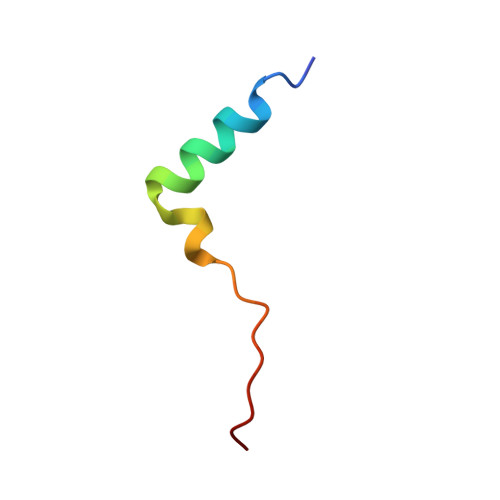Disruption of the productive encounter complex results in dysregulation of DIAPH1 activity.
Theophall, G.G., Ramirez, L.M.S., Premo, A., Reverdatto, S., Manigrasso, M.B., Yepuri, G., Burz, D.S., Ramasamy, R., Schmidt, A.M., Shekhtman, A.(2023) J Biological Chem 299: 105342-105342
- PubMed: 37832872
- DOI: https://doi.org/10.1016/j.jbc.2023.105342
- Primary Citation of Related Structures:
8FG1 - PubMed Abstract:
The diaphanous-related formin, Diaphanous 1 (DIAPH1), is required for the assembly of Filamentous (F)-actin structures. DIAPH1 is an intracellular effector of the receptor for advanced glycation end products (RAGE) and contributes to RAGE signaling and effects such as increased cell migration upon RAGE stimulation. Mutations in DIAPH1, including those in the basic "RRKR" motif of its autoregulatory domain, diaphanous autoinhibitory domain (DAD), are implicated in hearing loss, macrothrombocytopenia, and cardiovascular diseases. The solution structure of the complex between the N-terminal inhibitory domain, DID, and the C-terminal DAD, resolved by NMR spectroscopy shows only transient interactions between DID and the basic motif of DAD, resembling those found in encounter complexes. Cross-linking studies placed the RRKR motif into the negatively charged cavity of DID. Neutralizing the cavity resulted in a 5-fold decrease in the binding affinity and 4-fold decrease in the association rate constant of DAD for DID, indicating that the RRKR interactions with DID form a productive encounter complex. A DIAPH1 mutant containing a neutralized RRKR binding cavity shows excessive colocalization with actin and is unresponsive to RAGE stimulation. This is the first demonstration of a specific alteration of the surfaces responsible for productive encounter complexation with implications for human pathology.
- Department of Chemistry, State University of New York at Albany, Albany, New York, USA.
Organizational Affiliation:

















